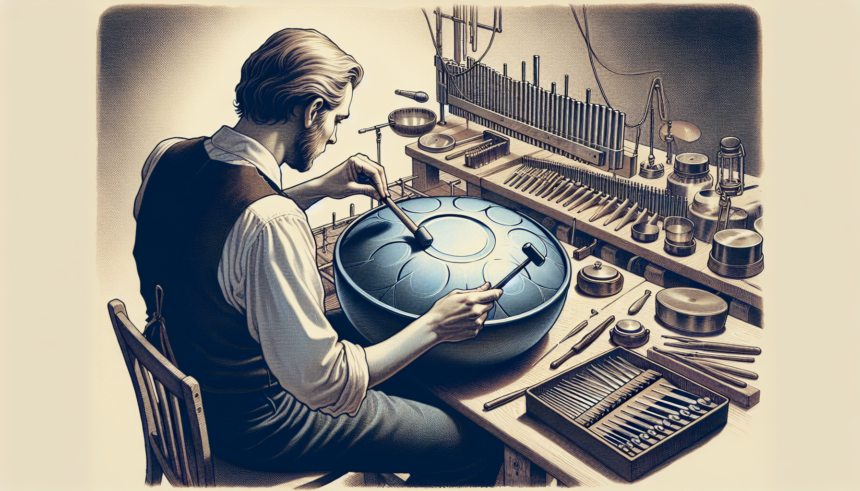The handpan is a unique and ethereal instrument that has captivated musicians and audiences alike. Its distinctly resonant and melodic tones are the result of meticulous tuning, a process that requires skill, patience, and precision. Whether you are a seasoned tuner or a curious beginner, mastering the art of handpan tuning can be a fulfilling endeavor. This article delves into expert advice on tuning techniques, tools, and common pitfalls to help you fine-tune your craft.
Understanding the Basics of Handpan Tuning
Tuning a handpan isn’t just about hitting the right notes; it involves creating a harmonious blend of overtone series and ensuring the instrument maintains its iconic sound. Each note on the handpan is carefully hammered into the steel, with a delicate balance of fundamental, octave, and fifth overtones. The process begins with tuning the fundamental note, followed by adjusting its corresponding overtones.
The Essential Tools for Handpan Tuning
Like any craft, having the right tools is paramount in handpan tuning. Here are some essentials:
- Tuning Hammers: Different sizes and weights of hammers are used to adjust the pitch by either raising or lowering it. The heavier the hammer, the more significant the impact on pitch change.
- Electronic Tuner: A reliable tuner helps in determining the exact pitch and guiding adjustments.
- Stability Stand: This provides a steady base for the handpan, ensuring precision hits and reducing wobbling.
Professional Tips for Handpan Tuning
Expert tuners have honed their skills through years of practice and experimentation. Here are some tips from the pros:
1. Patience and Precision
Tuning a handpan is a delicate process that can’t be rushed. Take your time with each note, making small, incremental adjustments rather than drastic changes. This ensures that you don’t overshoot the desired pitch and can better control the instrument’s overall sound.
2. Develop a Keen Ear
While electronic tuners are invaluable, developing a sharp, discerning ear is critical. This skill allows you to detect subtle tonal variations and harmonics that the tuner may not pick up. Regularly practice tuning by ear to enhance this ability.
3. Understand Material Behavior
Different materials react differently to hammering. Stainless steel, for example, may require more precise and gentle hammering than nitrided steel. Understanding the nuances of your handpan’s material can significantly affect the tuning process.
4. Temperature and Environment
Temperature changes can affect the metal’s properties. Tune your handpan in a stable environment to ensure consistency. Avoid environments that are too hot or too cold, as extreme temperatures can alter the tuning.
5. Keep Your Tools in Optimal Condition
A well-maintained tool kit is essential for successful tuning. Regularly check your hammers for signs of wear and tear, and ensure your electronic tuner is properly calibrated. Clean and store your tools in a safe environment to prolong their lifespan.
Common Pitfalls and How to Avoid Them
Even experienced tuners encounter challenges. Here are some common pitfalls and how to avoid them:
1. Over-Hammering
One of the most common mistakes is striking the notes too hard or too often. This can deform the note area and make tuning more challenging. Aim for gentle taps and small adjustments, especially as you get closer to the desired pitch.
2. Ignoring Overtone Balance
Focusing solely on the fundamental note’s pitch and neglecting the overtones can result in an unbalanced sound. Always check and adjust the overtones to maintain the harmonic integrity of each note.
3. Inconsistent Strike Zones
Hitting the notes in varying spots can lead to inconsistent tuning. Establish a consistent strike zone and practice your hammering technique to ensure uniformity across the instrument.
4. Neglecting Maintenance
Regularly maintaining your handpan can prolong its lifespan and keep its tune. Clean it after use, and store it in a controlled environment. Periodically check for any signs of rust or damage and address them promptly.
The Path to Mastery
Becoming a master handpan tuner isn’t an overnight journey. It involves spending countless hours honing your technique, understanding the instrument’s intricacies, and continually learning from your experiences and mistakes. Here are some steps to guide you along the way:
1. Consistent Practice
Like any skill, practice is essential. Regularly dedicate time to tune different handpans, learning how each one reacts to adjustments. This helps to develop a versatile and adaptable tuning approach.
2. Join a Community
Engage with other handpan enthusiasts and tuners. Influences and insights from others can offer new techniques, valuable feedback, and a support system. Attend workshops, participate in forums, and collaborate with other musicians to exchange knowledge.
3. Document Your Progress
Keep a journal of your tuning sessions, noting specific adjustments, outcomes, and any anomalies. This documentation can help identify patterns and improve your understanding of the tuning process over time.
4. Seek Mentorship
Learn from the masters. Finding a mentor who can provide guidance, critique your techniques, and share their experience is invaluable. Watch and learn from tutorials, attend live demonstrations, and don’t hesitate to ask questions.
5. Experiment Confidently
Don’t be afraid to experiment. Each handpan is unique, and what works for one may not work for another. Trying different techniques, tools, or strategies can lead to breakthroughs and innovations in your tuning approach.
Conclusion
Mastering the art of handpan tuning is an ongoing journey that combines technical skills, artistic sensibility, and a deep understanding of the instrument. With patience, practice, and the right guidance, you can develop the expertise needed to bring out the best in every handpan. Remember that every tuner’s path is unique, and the pursuit of perfection is what makes this craft endlessly engaging.
FAQs
1. How often should I tune my handpan?
The frequency of tuning depends on usage and environmental factors. Regular players may need to tune their handpan every 6-12 months, while occasional players might only require tuning once a year.
2. Can I tune my handpan using only an electronic tuner?
While an electronic tuner is a helpful tool, relying solely on it may not yield the best results. Developing an ear for tuning is crucial for achieving a balanced sound that electronic tuners might miss.
3. How can I prevent my handpan from going out of tune?
Proper care and maintenance are key. Avoid exposing your handpan to extreme temperatures, humidity, and physical shocks. Regular cleaning and safe storage can also help in maintaining its tune.
4. What should I do if I accidentally dent my handpan?
If your handpan gets dented, avoid attempting to fix it yourself unless you have the expertise. Consult a professional tuner to assess and repair the damage properly.
5. Are there different tuning styles for handpans?
Yes, handpans can be tuned to various scales and tuning styles, each offering a unique sound. Common tunings include D minor, Celtic minor, and Integral. The choice of tuning style depends on the player’s preference and musical purpose.





